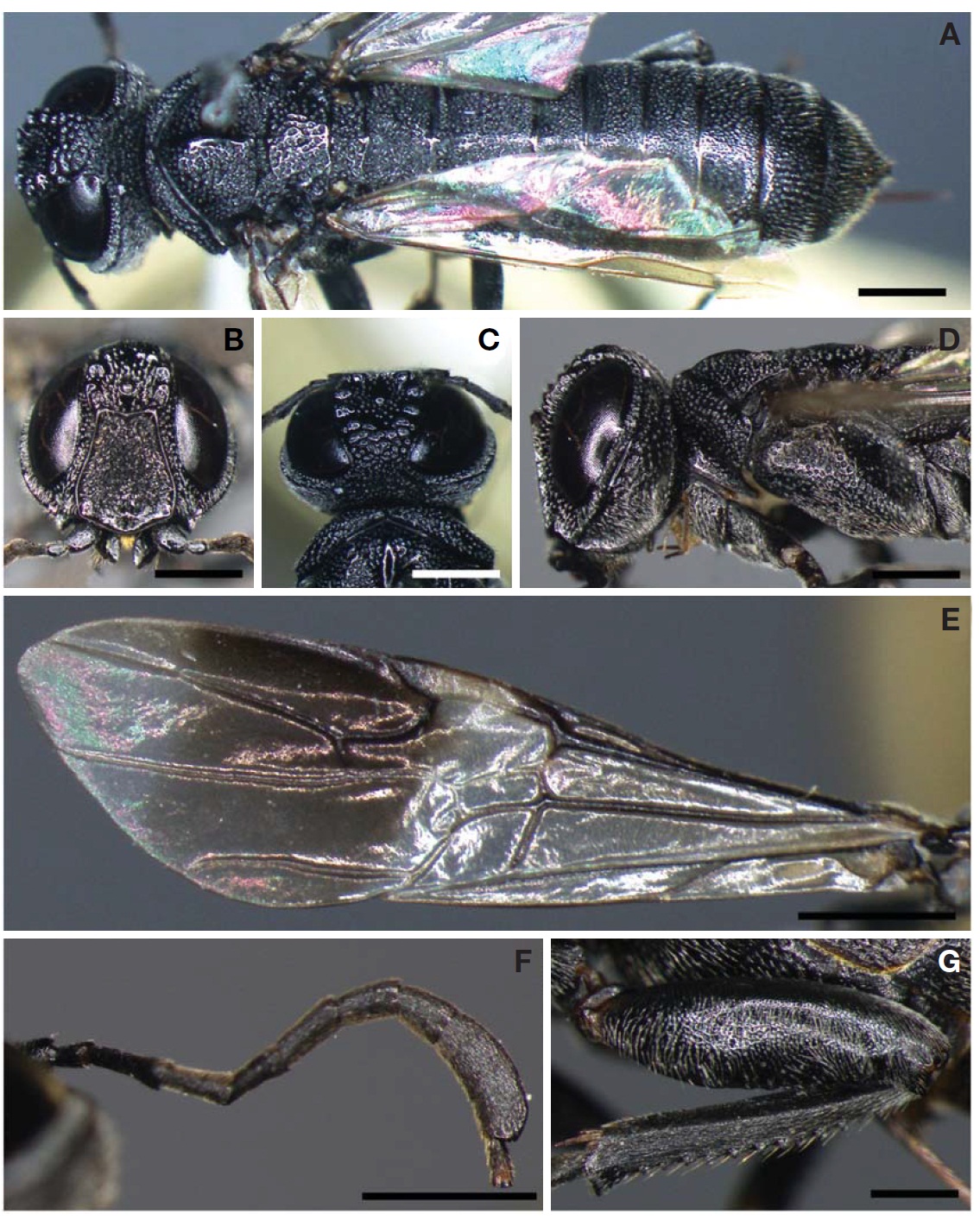



The family Orussidae is a unique parasitoid group belonging to the suborder Symphyta. Members of Orussidae are rare and only a species, Orussus coreanus Takeuchi have been previously recorded from Korea. In this study, we report another species, Stirocorsia tosensis (Tosawa and Sugihara, 1934), for the first time from Korea. The adult characteristics of the species with illustrations and a species key to the Korean Orussidae are provided.
The family Orussidae is a unique parasitoid group belonging to the suborder Symphyta. Members of the Orussidae are known as idiobiont ectoparasitoids of wood boring beetle larvae such as Buprestidae and Cerambycidae. The family Orussidae occupies an important position in the evolution and phylogeny of the Hymenoptera. Recent hymenopteran phylogenies support a monophyly of the family Orussidae as a sister group of the Apocrita (see Ronquist et al., 1999; Vilhelmsen, 2001). This implies that Orussidae and Apocrita share the common ancestor with the synapomorphic trait, “parasitism” (Vilhelmsen, 2003).
The Orussidae is a small family with about 75 species in 16 extant genera worldwide (Vilhelmsen, 2003). The family Orussidae is distinguished from other symphytan families by 1) cylindrical body shape; 2) head with ocular corona around median ocellus; 3) antenna inserted below ventral margin of eye; 4) no constriction between 1st and 2nd abdo-minal segment; and 5) female with long and thin ovipositor. Members of Orussidae are rare and only a species,
Recently we collected an orussid specimen which is dif-ferent from
Morphological terminology used in this study follows Benson (1938) and Togashi (2000). Specimens are examined by the stereomicroscope (Zeiss Stemi SV 11 Apo, Germany; Olympus SZX10, Japan). The examined specimen is deposited in the National Institute of Biological Resources (NIBR), Incheon, Korea.
Order Hymenoptera
Family Orussidae
Genus Stirocorsia Konow, 1897
1*Stirocorsia tosensis (Tosawa and Sugihara, 1934)
Ophrynopus tosensis: Guiglia 1937: 423.
Orussus tosensis:Takeuchi 1938: 177.
Stirocorsia tosensis: Benson 1938: 8 (as Stiricorsia); Togashi 2000: 105, 106 (as Stiricorsia); Vilhelmsen and Smith 2002: 393, 417.
Material examined. 1 female, Korea: Gyeongsangbuk-do, Cheongdo-gun, Unmun-myeon, Sinwon-ri, Seonjaemaeul, 4 Sep 2009, Yeo JD Coll.
Description (Fig.1 A-G). Body length 10 mm. Body black except dark brown tarsi of legs. Forewing with infuscated band. Stigma of forewing white except dark brown basal and apical margins.
Head: Ocellar corona present around median ocellus. Vertex reticulate to foveate. Frons areolate with well developed lateral longitudinal frontal carinae and dorsal and ventral transverse frontal carinae. Subantennal groove well developed;median longitudinal frontal carina absent. Postocular carina fully developed and extending for a considerable distance above lower margin of eyes. Occiput with weak concavity dorsally; occipital carinae complete. Maxillary palps with 5 segments; labial palps with 3 segments. Third antennal seg-ment twice as long as second; ninth antennal segment expand-ed distally.
Thorax: Pronotum foveate, with short longitudinal carina medially. Mesoscutum reticulate to foveate with well devel-oped, smooth and polish longitudinal carina medially; mesos-cutellar sulcus distinct. Mesoscutellum foveate, rounded posteriorly. Mesopleuron foveate; mesosubalar carina pre-sent; mesepistemal carina absent. Metanotum reticulate. Hind femur with posteroventral corners protruding; without den-ticles ventrally. Hind tibia with two parallel rows of distinct pegs dorsally; with longitudinal carina ventrally. Hind basi-tarsus slightly longer than the following three segments combined.
Abdomen: 1st tergite reticulate with well developed post-spiracular carina. 8th tergite with well developed projection posteromedially.
Distribution. Korea and Japan.
Remarks. No host species has been reported, but Guiglia (1966) collected
Taxonomic key to Korean species of Orussidae
1. Frons entirely black with delimited central area by well developed lateral longitudinal frontal carinae and dorsal and ventral transverse frontal carinae (Fig.1 B). Abdomen entirely black (Fig.1 A). Forewing vein 2r arising from pterostigma about 2/3rds from base of latter (Fig.1 E) ????????????????????
- Frons without delimited area by frontal carinae but with dorsoventrally elongate pale yellow marks on inner mar-gins of compound eyes. Abdominal tergites 3-7 red to reddish brown. Forewing vein 2r arising from middle of pterostigma ????????????????????????????????
Korean name: 1* 검정벌레살이송곳벌 (신칭)

